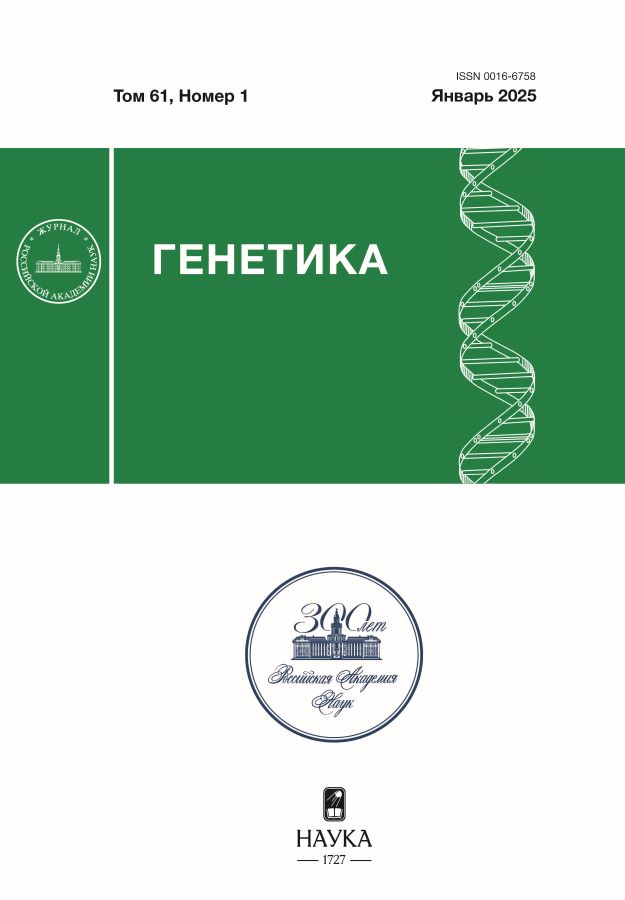Polymorphism of the NIPAL1 gene rs135173498 as a marker of embryonic lethality in auliekol cattle
- Autores: Belaya A.V.1, Klimanova Е.A.2, Norkina V.M.2, Beishova I.S.3
-
Afiliações:
- Belarusian State Pedagogical University named after Maxim Tank
- Novosibirsk State Agrarian University
- Zhangir Khan West Kazakhstan Agrarian Technical University
- Edição: Volume 61, Nº 1 (2025)
- Páginas: 67-73
- Seção: ГЕНЕТИКА ЖИВОТНЫХ
- URL: https://ruspoj.com/0016-6758/article/view/686167
- DOI: https://doi.org/10.31857/S0016675825010068
- EDN: https://elibrary.ru/VEPCSW
- ID: 686167
Citar
Texto integral
Resumo
It was found that in Auliekol cattle, SNP G/A rs135173498 associated with live weight at birth (p-value = 2.71E-06) is characterized by the absence of live-born calves homozygous for the rare genotype with a significant sample size of 497 animals. At the same time, calves with a heterozygous genotype were not characterized by a decrease in live weight at birth relative to the values of this indicator for the sample as a whole. The article analyzes possible mechanisms for the development of the phenotypic effect of SNP rs135173498 of the NIPAL1 gene as a factor of embryonic lethality in Auliekol cattle, and, presumably, in the Kazakh Whitehead, Aberdeen Angus and Charolais breeds.
Palavras-chave
Texto integral
Sobre autores
A. Belaya
Belarusian State Pedagogical University named after Maxim Tank
Autor responsável pela correspondência
Email: Kolyuchka005@rambler.ru
Belarus, Minsk
Е. Klimanova
Novosibirsk State Agrarian University
Email: Kolyuchka005@rambler.ru
Rússia, Novosibirsk
V. Norkina
Novosibirsk State Agrarian University
Email: Kolyuchka005@rambler.ru
Rússia, Novosibirsk
I. Beishova
Zhangir Khan West Kazakhstan Agrarian Technical University
Email: Kolyuchka005@rambler.ru
Cazaquistão, Uralsk
Bibliografia
- Шайдуллин Р.Р., Фаизов Т.Х., Ганиев А.С. Характер распространения летальных генов у молочного скота // Уч. записки КГАВМ им. Н. Э. Баумана. 2015. № 2. C. 242–244. https://doi.org/cyberleninka.ru/article/n/harakter-rasprostraneniya-letalnyh-genov-u-molochnogo-skota
- Charlier C., Coppieters W., Rollin F. et al. Highly effective snp-based association mapping and management of recessive defects in livestock // Nat. Genet. 2008. V. 40. P. 449–454. https://doi.org/10.1038/ng.96
- Van Raden P.M., Olson K.M., Null D.J. et al. Harmful recessive effects on fertility detected by absence of homozygous haplotypes // J. Dairy Sci. 2011. № 94. P. 6153–6161. https://doi.org/10.3168/jds.2011-4624
- Fritz S., Capitan A., Djari A. et al. Detection of haplotypes associated with prenatal death in dairy cattle and identification of deleterious mutations in gart, shbg and slc37a2 // PLoS One. 2013. V. 8. № 6. https://doi.org/10.1371/journal.pone.0065550
- Cooper T.A., Wiggans G.R., Van Raden P.M. et al. Genomic evaluation of ayrshire dairy cattle and new haplotypes affecting fertility and stillbirth in holstein, brown swiss and ayrshire breeds // http://aipl.arsusda.gov
- Sonstegard T.S., Cole J.B., Van Raden P.M. et al. Identification of a nonsense mutation in cwc15 associated with decreased reproductive efficiency in jersey cattle // PLoS One. 2013. V. 8. № 1. P. 1–6. https://doi.org/10.1371/journal.pone.0054872
- McClure M., Kim E., Bickhart D. et al. Fine mapping for weaver syndrome in brown swiss cattle and the identification of 41 concordant mutations across nrcam, pnpla8 and cttnbp2 // PLoS One. 2013. V. 8. № 3. P. 1–16. https://doi.org/10.1371/journal.pone.0059251
- Kadri N.K., Sahana G., Charlier C. et al. A 660-Kb deletion with antagonistic effects on fertility and milk production segregates at high frequency in nordic red cattle: Additional evidence for the common occurrence of balancing selection in livestock // PLoS Genet. 2014. V. 10. № 1. P. 1–11. https://doi.org/10.1371/journal.pgen.1004049
- Häfliger I.M., Spengeler M., Seefried F.R. et al. Four novel candidate causal variants for deficient homozygous haplotypes in holstein cattle // Sci. Rep. 2022. № 12. P. 1–13. https://doi.org/10.1038/s41598-022-09403-6
- Cooper T.A., Wiggans G.R., Null D.J. et al. Genomic evaluation, breed identification, and discovery of a haplotype affecting fertility for ayrshire dairy cattle // J. Dairy Sci. 2014. V. 97. № 6. P. 3878–3882. https://doi.org/10.3168/jds.2013-7427
- Гладырь Е.А., Терновская О.А., Костюнина О.В. Скрининг гаплотипа фертильности АН1 айрширской породы крупного рогатого скота Центрального и Северо-Западного регионов России // АгроЗооТехника. 2018. Т. 1. № 4. С. 1–13. https://doi.org/10.15838/alt.2018.1.4.1
- Зиновьева Н.А. Гаплотипы фертильности голштинского скота // С.-х. биология. 2016. Т. 51. № 4. C. 423–435. https://doi.org/10.15389/agrobiology.2016.4.423rus
- Белая Е.В., Наметов А.М., Шамшидин А.С. Полногеномный поиск ассоциаций c QTL мясной продуктивности у скота казахской белоголовой и аулиекольской пород // Главный зоотехник. 2022. № 7. С. 3–11. https://doi.org/10.33920/sel-03-2207-01
- Белая Е.В. Биологические функции породоспецифичных SNP-маркеров мясной продуктивности у крупного рогатого скота казахской белоголовой и аулиекольской пород // Генетика и разведение животных. 2022. № 2. С. 33–39. https://doi.org/10.31043/2410-2733-2022-2-33-39
- Белая Е.В., Бейшова И.С., Селионова М.И. и др. Полногеномный поиск QLT-ассоциированных SNP для прогнозирования наследственного потенциала продуктивности у казахского белоголового скота // Вестник АПК Ставрополья. 2022. № 3(47). С. 18–25. https://doi.org/10.31279/2222-9345-2022-11-47-18-25
- Purcell S.M., Neale B., Todd-Brown K. et al. PLINK: A tool set for whole-genome association and population-based linkage analyses // Am. J. Hum. Genet. 2007. V. 81. P. 559–575. https://doi.org/10.1086/519795
- Manialawy Y., Khan S.R., Bhattacharjee A. et al. The magnesium transporter nipal1 is a pancreatic islet-expressed protein that conditionally impacts insulin secretion // J. Biol. Chem. 2020. V. 295. P. 9879–9892. https://doi.org/10.1074/jbc.RA120.013277
- Dadousis C., Somavilla A., Ilska J.J. et al. A genome-wide association analysis for body weight at 35 days measured on 137,343 broiler chickens // Genet. Sel. Evol. 2021. V. 53(1). P. 1–14. https://doi.org/10.1186/s12711-021-00663-w
- Wei W., Gao W., Li Q. et al. Comprehensive characterization of posttranscriptional impairment-related 3′-utr mutations in 2413 whole genomes of cancer patients // NPJ Genom. Med. 2022. V. 7. P. 1–12. https://doi.org/10.1038/s41525-022-00305-0
- Mayr C. What are 3’ utrs doing? // Cold. Spring. Harb. Perspect Biol. 2019. № 10. P. 1–15. https://doi.org/10.1101/cshperspect.a034728
- Duff M.O., Olson S., Wei X. et al. Genome-wide identification of zero nucleotide recursive splicing in drosophila // Nature. 2015. №. 521(7552). P. 376–379. https://doi.org/10.1038/nature14475
- Beishova I., Dossybayev K., Shamshidin A. et al. Distribution of homozygosity regions in the genome of Кazakh cattle breeds // Diversity. 2022. V. 14(4). P. 1–11. https://doi.org/10.3390/d14040279
Arquivos suplementares














